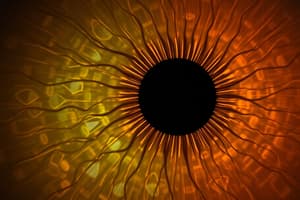Podcast
Questions and Answers
What are the two types of photoreceptors in the retina?
What are the two types of photoreceptors in the retina?
Cones and rods
Which system is adapted for day vision?
Which system is adapted for day vision?
- Photopic (correct)
- Scotopic
- Mesopic
- None of the above
Rods are responsible for color discrimination.
Rods are responsible for color discrimination.
False (B)
Motion is better detected in __________ vision.
Motion is better detected in __________ vision.
Match the cone photopigments with their respective colors:
Match the cone photopigments with their respective colors:
What is a major risk factor for developing glaucoma?
What is a major risk factor for developing glaucoma?
Which of the following are generic names of erectile dysfunction drugs? (Select all that apply)
Which of the following are generic names of erectile dysfunction drugs? (Select all that apply)
Taking erectile dysfunction drugs may lead to blurred vision and sensitivity to light.
Taking erectile dysfunction drugs may lead to blurred vision and sensitivity to light.
Which drug is associated with nonarteritic anterior ischemic optic neuropathy?
Which drug is associated with nonarteritic anterior ischemic optic neuropathy?
What is the primary usage of Tamoxifen?
What is the primary usage of Tamoxifen?
__________ is an anticonvulsant used to treat seizure disorders and prevent migraine headaches.
__________ is an anticonvulsant used to treat seizure disorders and prevent migraine headaches.
What is a common sign of Vitamin A deficiency in the eyes?
What is a common sign of Vitamin A deficiency in the eyes?
Flashcards are hidden until you start studying
Study Notes
UV Radiation and Vision
- UV radiation damages the cornea and anterior structures
- Polycarbonate absorbs most UV radiation
- Visible light has a wavelength of 400-700 nm
Photoreceptors in the Retina
- There are two types of photoreceptors: cones and rods
- Cones are responsible for color vision and are concentrated in the fovea centralis
- Rods are responsible for peripheral and night vision
Rods
- Absence of color discrimination
- Poor acuity (~20/200)
- Best discrimination about 30 minutes after darkness
- Predominate in peripheral vision
- Peripheral vision is more sensitive in dim conditions
- Motion is better detected in peripheral vision
- Rods shed and are recycled by the RPE (retinal pigment epithelium)
Retinitis Pigmentosa (RP)
- A genetic disorder characterized by the death of photoreceptors
- Bony spicules may be present in the retina
- All disc waste remains in the eye and damages the retina
- Some RP patients may have healthy-looking retinas but have trouble seeing; ERG (electroretinogram) is needed to diagnose
- Not all RP cases are genetic
Rhodopsin
- A photopigment found in rod discs
- Each eye has 120 million rods, each with 1,000 discs, and each disc has 10,000 molecules of rhodopsin
- The large number of rhodopsin molecules allows the eye to capture light and increases sensitivity at nighttime
- Weber's fraction (ΔI/I) = 0.14, representing the minimum change in stimuli needed to alter vision
Cones
- About 6-7 million cones per eye
- Remain constant with age
- Color sensitive
- Good acuity (20/20)
- Adapt rapidly
- Weber's fraction (ΔI/I) = 0.015, representing better contrast sensitivity than rods
Cone Photopigments
- 3 photopigments in the eye: erythrolabe (red), chlorolabe (green), and cyanolabe (blue)
- Erythrolabe: peaks around 557 nm, most present (64%), and concentrated in the fovea centralis
- Chlorolabe: peaks around 530 nm, about 32% of all cones, and concentrated in the fovea centralis
- Cyanolabe: peaks around 426 nm, about 5-10% of all cones, and concentrated outside the fovea centralis
Dark Adaptation
- Sensitivity increases by 5 log units in about 35 minutes (100,000 more sensitive)
- First arm of the curve (cone section) plateaus after 10 minutes
- First arm of the curve breaks after 12 minutes (rod-cone break)
- The break represents the time when rods become more sensitive than cones
- Second arm of the curve plateaus after 35 minutes
- Represents the scotopic threshold for the specific wavelength
Other Retinal Disorders
- Congenital Stationary Night Blindness (CSNB): a genetic disorder affecting rod function, primarily X-linked recessive
- Traumatic Retinopathy: mimics RP, caused by traumatic injuries
- Syphilis: can cause retinal damage
- Rubella: can cause abortions, eruptions in skin, and can be mistaken with RP
- Thioridazine Retinopathy: an anti-psychotic medication causing crystalline deposits in the retina, confused with RP
Argus II: Bionic Eye
- A device that gives black and white detection, outlines, borderlines, and patterns to RP patients
- Artificial retina; helps RP patients
Medications Affecting the Eye
- Acne medication (Isotretinoin): can cause dry eyes and sudden decrease in night vision
- Antihistamines: can cause angle-closure glaucoma in some people
- Antimalarial drugs (Chloroquine, Hydroxychloroquine): can cause retinal toxicity, leading to vision loss
- Corticosteroids (Prednisone): increase the risk of cataract and glaucoma (steroid responders)
- Erectile dysfunction drugs (Sildenafil, Tadalafil, Vardenafil): can cause blurred vision, sensitivity to light, and seeing a blue tinge
- Ethambutol (Myambutol): an antibiotic used to treat TB, associated with optic neuropathy problems
- Tamoxifen (Nolvadex): an antiestrogen drug used to treat breast cancer, can lead to crystalline retinopathy
- Topiramate (Topamax): an anticonvulsant used to treat seizure disorders, associated with angle-closure glaucoma
- Vitamin A deficiency: required for synthesis of rhodopsin, can occur due to dietary restrictions or diseases
Studying That Suits You
Use AI to generate personalized quizzes and flashcards to suit your learning preferences.




